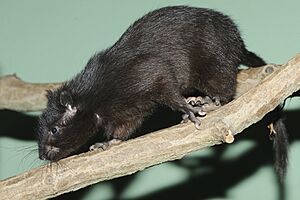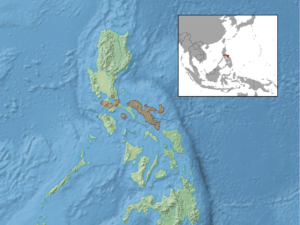Southern giant slender-tailed cloud rat facts for kids
Quick facts for kids Southern giant slender-tailed cloud rat |
|
|---|---|
 |
|
| Conservation status | |
| Scientific classification | |
| Genus: |
Phloeomys
|
| Species: |
cumingi
|
 |
|
| Synonyms | |
|
Capromys elegans Cabrera, 1901 |
|
The southern giant slender-tailed cloud rat (Phloeomys cumingi), also called the southern Luzon giant cloud rat, is a special type of rodent. People in the Philippines sometimes call it bugkon. This large rat only lives in the southern part of Luzon island in the Philippines. It is considered a vulnerable species, which means its numbers are going down, and it needs our help to survive.
Contents
What Does It Look Like?
This cloud rat is mostly dark brown. Sometimes, it might have a bit of reddish color in its fur. Unlike its close relative, the northern Luzon giant cloud rat, it usually doesn't have light-colored patches. It is a very big rodent! It can be about 67 to 75 centimeters (26 to 30 inches) long, including its tail. It weighs around 1.45 to 2.1 kilograms (3.2 to 4.6 pounds). That's like carrying a small bag of sugar!
Where Does It Live and What Does It Do?
The southern giant slender-tailed cloud rat is good at living both high up in trees and on the forest floor. It moves slowly and is only active at night. During the day, it rests and sleeps in hollow trees or logs.
These rats usually live alone. Sometimes, you might find them in pairs, like a male and female together. A mother and her young might also live together. Bigger groups have been seen too, but this is less common.
What Does It Eat?
The main food for the southern giant slender-tailed cloud rat is tender, young leaves. They love to munch on fresh, soft leaves. They have also been seen eating fruit.
Life Cycle and Reproduction
Southern giant slender-tailed cloud rats usually have one baby, called a pup, each year. Most births happen during the late rainy season. The mother gives birth in a safe place. This can be inside a hollow standing tree, a fallen log, or even a hole in the ground.
When the baby is born, the mother carries it very carefully. The pup holds on tightly to one of her nipples. In zoos, some cloud rats have lived for more than 13 years! This shows they can live a long time if they are well cared for.


